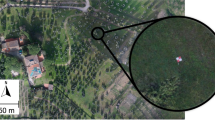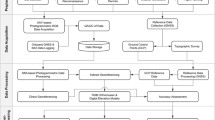Abstract
The recent development and proliferation of Unmanned Aircraft Systems (UASs) has made it possible to examine environmental processes and changes occurring at spatial and temporal scales that would be difficult or impossible to detect using conventional remote sensing platforms. However, new methodologies need to be codified in order to be compared with traditional photogrammetric products. This can be done by testing geometrical accuracies reached by the models when external orientations have changed. In this paper two dense point clouds, derived from the same spatial database, were compared to evaluate the discrepancies resulting from two different relative orientations: the first one based on the GPS position of each UAV frame and the second one based on GCPs, measured through GNSS positioning. The two dense point clouds presented an average offset of 3.4 cm and a standard deviation of 5 cm, proving that relative accuracy is only influenced by the matching intensity. To assign three different absolute orientations, the georeferencing procedure of the same orthomosaic was then verified based on GCPs coming from three different open geo-data sources. By evaluating the position discrepancies of some Independent Check Points (ICPs), the three open geo-data sources provided three estimates of different root-mean-square error (RMSE) positional accuracy, of which the absolute geometrical precision was the related function.
Access this chapter
Tax calculation will be finalised at checkout
Purchases are for personal use only
Similar content being viewed by others
References
Gioia, A., Iacobellis, V., Manfreda, S., Fiorentino, M.: Influence of infiltration and soil storage capacity on the skewness of the annual maximum flood peaks in a theoretically derived distribution. Hydrol. Earth Syst. Sci. 16, 937–951 (2012)
Iacobellis, V., Castorani, A., Di Santo, R.A., Gioia, A.: Rationale for flood prediction in karst endorheic areas. J. Arid Environ. 112(PA), 98–108 (2015)
Totaro, V., Gioia, A., Novelli, A., Caradonna, G.: The use of geomorphological descriptors and landsat-8 spectral indices data for flood areas evaluation: a case study of lato river basin. In: Gervasi, O., et al. (eds.) ICCSA 2017. LNCS, vol. 10407, pp. 30–44. Springer, Cham (2017). https://doi.org/10.1007/978-3-319-62401-3_3
Martínez-Espejo Zaragoza, I., Caroti, G., Piemonte, A., Riedel, B., Tengen, D., Niemeier, W.: Structure from motion (SfM) processing of UAV images and combination with terrestrial laser scanning, applied for a 3D-documentation in a hazardous situation. Geomat. Nat. Hazards Risk 8, 13 (2017)
Mangiameli, M., Muscato, G., Mussumeci, G., Milazzo, C.: A GIS application for UAV flight planning. IFAC Proc. Vol. 46, 147–151 (2013)
Caroti, G., Piemonte, A., Nespoli, R.: UAV-Borne photogrammetry: a low cost 3D surveying methodology for cartographic update. In: MATEC Web of Conferences, vol. 120, pp. 09005. EDP Sciences (2017)
Giordan, D., Hayakawa, Y., Nex, F., Remondino, F., Tarolli, P.: Review article: the use of remotely piloted aircraft systems (RPAS) for natural hazards monitoring and management. Nat. Hazards Earth Syst. Sci. Discuss. 2017, 1–26 (2017)
Nakano, T., Kamiya, I., Tobita, M., Iwahashi, J., Nakajima, H.: Landform monitoring in active volcano by UAV and SFM-MVS technique. In: The International Archives of the Photogrammetry, Remote Sensing and Spatial Information Sciences, vol. XL-8, pp. 71–75 (2014)
Nex, F., Remondino, F.: UAV for 3D mapping applications: a review. Appl. Geomat. 6, 1–15 (2014)
Remondino, F., Barazzetti, L., Nex, F., Scaioni, M., Sarazzi, D.: UAV photogrammetry for mapping and 3D modeling-current status and future perspectives. In: International Archives of the Photogrammetry, Remote Sensing and Spatial Information Sciences, vol. XXXVIII-1, p. C22 (2011)
Roncella, R.: Sviluppo e applicazioni di tecniche di automazione in fotogrammetria dei vicini (2018)
del Mar Saldana, M., Aguilar, M.A., Aguilar, F.: Generation and quality assessment of stereo-extracted DSM from GeoEye-1 and WorldView-2 imagery. IEEE Trans. Geosci. Remote Sens. 52, 1259–1271 (2014)
Pulighe, G., Baiocchi, V., Lupia, F.: Horizontal accuracy assessment of very high resolution google earth images in the city of Rome, Italy. Int. J. Digit. Earth 9, 342–362 (2016)
Teo, T.-A., Shih, P.T.-Y., Yu, S.-C., Tsai, F.: The use of UAS for rapid 3D mapping in geomatics education. In: The International Archives of the Photogrammetry, Remote Sensing and Spatial Information Sciences, vol. XLI-B6, pp. 95–100 (2016)
Congalton, R.G., Green, K.: Assessing the Accuracy of Remotely Sensed Data: Principals and Practices. Lewis Publishers, Boca Raton (2009)
Federal Geographic Data Committee: Geospatial Positioning Accuracy Standards - Part 3: National Standard for Spatial Data Accuracy . National Spatial Data Infrastructure (1998)
Potere, D.: Horizontal positional accuracy of google earth’s high-resolution imagery archive. Sensors 8, 7973 (2008)
Acknowledgements
The authors are grateful to VisualDrone (an Apulian start-up operating in the field of UAS) and to Dr. Antonio Novelli for their precious collaboration in the survey campaign.
Author information
Authors and Affiliations
Corresponding author
Editor information
Editors and Affiliations
Rights and permissions
Copyright information
© 2018 Springer International Publishing AG, part of Springer Nature
About this paper
Cite this paper
Saponaro, M., Tarantino, E., Fratino, U. (2018). Geometric Accuracy Evaluation of Geospatial Data Using Low-Cost Sensors on Small UAVs. In: Gervasi, O., et al. Computational Science and Its Applications – ICCSA 2018. ICCSA 2018. Lecture Notes in Computer Science(), vol 10964. Springer, Cham. https://doi.org/10.1007/978-3-319-95174-4_29
Download citation
DOI: https://doi.org/10.1007/978-3-319-95174-4_29
Published:
Publisher Name: Springer, Cham
Print ISBN: 978-3-319-95173-7
Online ISBN: 978-3-319-95174-4
eBook Packages: Computer ScienceComputer Science (R0)




